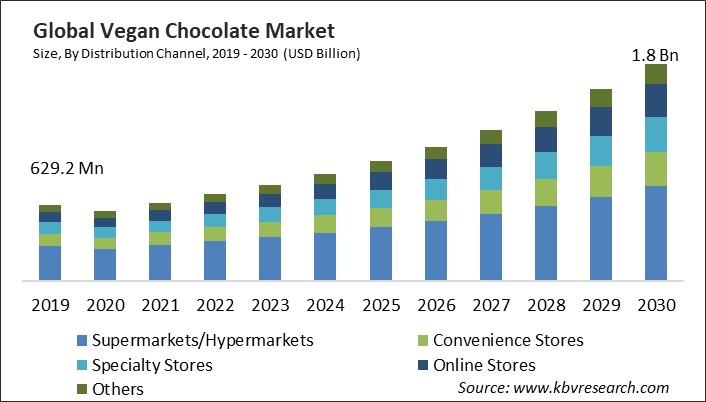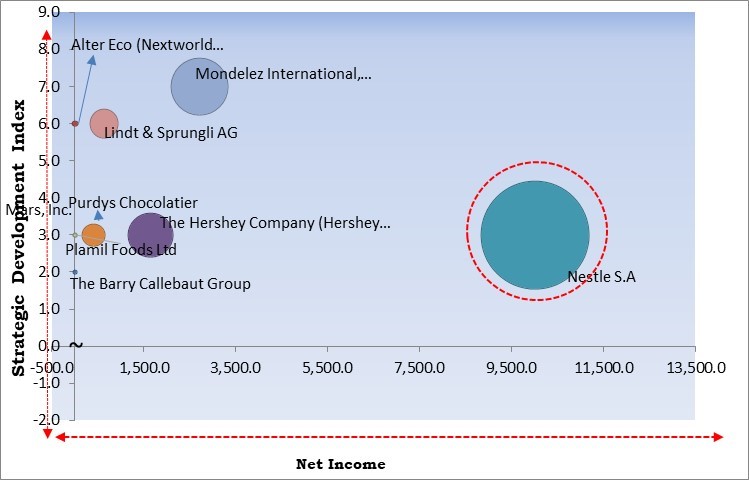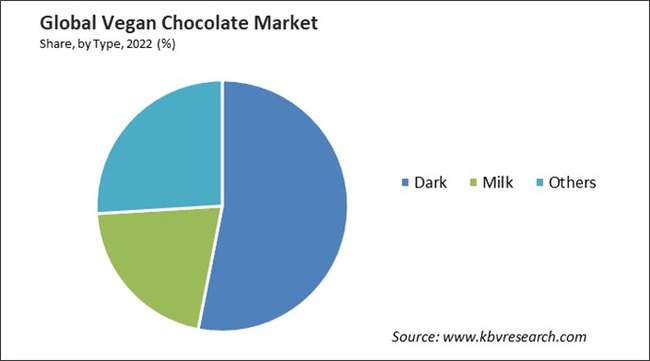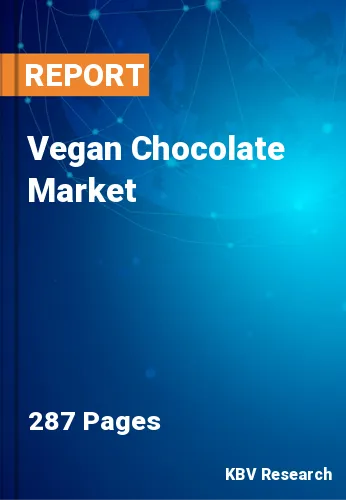The Global Vegan Chocolate Market size is expected to reach $1.8 billion by 2030, rising at a market growth of 12.4% CAGR during the forecast period. In the year 2022, the market attained a volume of 12,419.0 tonnes, experiencing a growth of 6.1% (2019-2022).
The adoption of specialty stores is pivotal in leading the market. Hence, the Specialty Stores segment will register more than 15% share in the market by 2030. Specialty stores exclusively offer high-quality and unique products, providing an ideal environment for promoting and selling vegan chocolate. Specialty stores attract a niche audience of consumers actively seeking out unique and premium products. These consumers are often more willing to explore vegan options and appreciate the quality and craftsmanship of specialty vegan chocolates. Specialty stores create a unique and immersive experience for customers seeking premium vegan chocolate products. Their ability to curate, educate, and offer exclusive items positions them as influential players in driving the growth of the market, particularly among discerning and ethically conscious consumers.

The major strategies followed by the market participants are Product Launches as the key developmental strategy in order to keep pace with the changing demands of end users. For instance, In January, 2021, Alter Eco launched two super-dark chocolate bars to its Blackout range, Total Blackout, and Raspberry Blackout. These new flavor bars contain Mint Blackout, Classic Blackout, and Super Blackout. In November, 2022, Mondelez International, Inc. rolled out the Cadbury Plant Bar, a new chocolatey confection for those looking for a vegan alternative to the classic.
Based on the Analysis presented in the KBV Cardinal matrix; Nestle S.A is the major forerunner in the Market. In February, 2021, Nestle introduced KitKat V, a vegan version of its KitKat bar. This launch aimed to fulfill the demand for a vegan substitute for KitKat candy. Companies such as Mondelez International, Inc., The Hershey Company (Hershey Trust Company), and Lindt & Sprungli AG are some of the key innovators in the Market.

Increasing awareness of the health benefits associated with plant-based diets has driven consumer interest in vegan chocolate. Many individuals perceive vegan chocolate as a healthier alternative to traditional milk chocolate due to its lower saturated fat content and potential absence of allergens like dairy and lactose. Consumers' increasing health and wellness consciousness has increased interest and demand for these products. As consumers prioritize their health and make more informed food choices, the market will likely benefit from this trend, further promoting its growth and innovation.
The expanding vegan population has significantly impacted the growth of the market. As more people adopt vegan lifestyles, the demand for vegan-friendly products, including vegan chocolate, has increased. The increase in the number of vegans directly expands the potential customer base for vegan chocolate. As more individuals embrace vegan and plant-based lifestyles for various reasons, the demand for vegan chocolate products is expected to continue to rise, prompting further innovation and expansion within the market. Thus, the expanding vegan population is a significant driver of growth in the market.
The higher price of vegan chocolates makes them less accessible to many consumers, especially those on a tight budget. This limits the market's growth potential because many potential customers may opt for more affordable non-vegan chocolate alternatives. When vegan chocolates are significantly more expensive than traditional chocolates, they may be perceived as a luxury or niche product. This may deter potential consumers from even considering vegan options. Higher prices slow the adoption of these chocolates among consumers who are curious about plant-based options but are hesitant due to cost concerns. Slower adoption rates impede market growth.
By type, the market is categorized into dark, milk and others. In 2022, the dark segment held the highest revenue share in the market. It is frequently regarded as a healthier alternative to milk chocolate. The National Library of Medicine classifies dark chocolate as a functional diet due to its anti-inflammatory, anti-diabetic, and antimicrobial properties. The dark chocolate segment is predicted to expand significantly due to shifting consumer preferences and the rising popularity of premium and artisanal chocolates.

Based on distribution channel, the market is classified into supermarkets/hypermarkets, convenience stores, specialty stores, online stores, and others. The convenience stores segment acquired a substantial revenue share in the market in 2022. Convenience stores are widespread and easily accessible, making them an ideal distribution channel to reach a broad and diverse customer base. People of all backgrounds and dietary preferences frequent convenience stores, introducing this chocolate to a wider audience easier. The convenience store segment drives the market by providing accessibility, exposure, and convenience to a diverse consumer base. By strategically positioning and marketing vegan chocolate products, manufacturers and retailers tap into the growing demand for plant-based options in the snacking and confectionery sector.
| Report Attribute | Details |
|---|---|
| Market size value in 2022 | USD 721.3 Million |
| Market size forecast in 2030 | USD 1.8 Billion |
| Base Year | 2022 |
| Historical Period | 2019 to 2021 |
| Forecast Period | 2023 to 2030 |
| Revenue Growth Rate | CAGR of 12.4% from 2023 to 2030 |
| Number of Pages | 287 |
| Number of Table | 553 | Quantitative Data | Volume in Tonnes, Revenue in USD Million, and CAGR from 2019 to 2030 |
| Report coverage | Market Trends, Revenue Estimation and Forecast, Segmentation Analysis, Regional and Country Breakdown, Competitive Landscape, Companies Strategic Developments, Company Profiling |
| Segments covered | Type, Distribution Channel, Region |
| Country scope | US, Canada, Mexico, Germany, UK, France, Russia, Spain, Italy, China, Japan, India, South Korea, Singapore, Malaysia, Brazil, Argentina, UAE, Saudi Arabia, South Africa, Nigeria |
| Growth Drivers |
|
| Restraints |
|
Region-wise, the market is analysed across North America, Europe, Asia Pacific, and LAMEA. In 2022, the Europe region led the market by generating the highest revenue share. Europe has seen a rise in consumers adopting vegan or plant-based diets, driven by concerns about animal welfare, health, and sustainability. This trend has boosted the demand for vegan chocolate. Many European consumers are concerned about the ethical treatment of animals and the environmental impact of traditional dairy chocolate production. Vegan chocolate, which uses plant-based ingredients, is considered more ethical and sustainable.
Free Valuable Insights: Global Vegan Chocolate Market size to reach USD 1.8 Billion by 2030
The market research report covers the analysis of key stakeholders of the market. Key companies profiled in the report include The Hershey Company (Hershey Trust Company), Nestle S.A, Mars, Inc., Alter Eco (Nextworld Evergreen), Mondelez International, Inc., The Barry Callebaut Group, Plamil Foods Ltd, Lindt & Sprungli AG, Ludwig Weinrich GmbH & Co. KG, and Purdys Chocolatier
By Distribution Channel (Volume, Tonnes, USD Million, 2019-2030)
By Type (Volume, Tonnes, USD Million, 2019-2030)
By Geography (Volume, Tonnes, USD Million, 2019-2030)
This Market size is expected to reach $1.8 billion by 2030.
Rising health and wellness consciousness are driving the Market in coming years, however, Adverse effect of price premium restraints the growth of the Market.
The Hershey Company (Hershey Trust Company), Nestle S.A, Mars, Inc., Alter Eco (Nextworld Evergreen), Mondelez International, Inc., The Barry Callebaut Group, Plamil Foods Ltd, Lindt & Sprungli AG, Ludwig Weinrich GmbH & Co. KG, and Purdys Chocolatier
In the year 2022, the market attained a volume of 12,419.0 tonnes, experiencing a growth of 6.1% (2019-2022).
The Supermarkets/Hypermarkets Segment is leading the Market, by Distribution Channel in 2022; thereby, achieving a market value of $786.7 Million by 2030.
The Europe region dominated the Market, by Region in 2022, and would continue to be a dominant market till 2030; thereby, achieving a market value of $633.4 Million by 2030.
Our team of dedicated experts can provide you with attractive expansion opportunities for your business.

